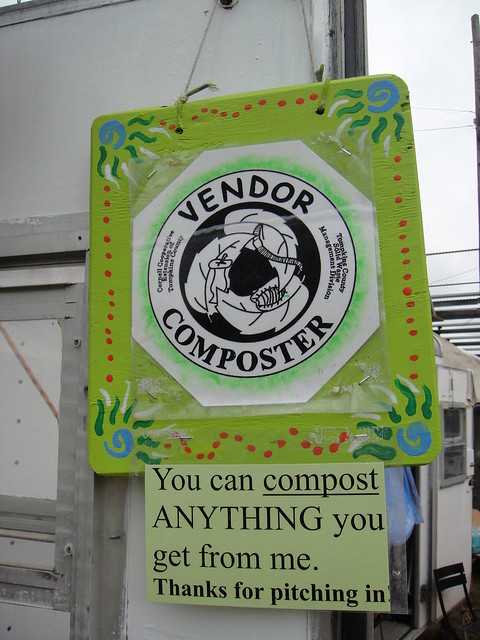I’ve been in conversations recently about zero-waste goals for outdoor events. It’s not as difficult as it sounds, and there are multiple benefits … but there is a learning curve. This article first appeared in my personal blog. I’m bringing it out here, as it will have a greater probabilility of reaching those who need it.
The Hubby and I do two music festivals in NY, mostly selling Chocolate Dipped Strawberries, Frozen Bananas, and Cheesecake. The festivals are Clearwater’s Great Hudson River Revival and the Fingerlakes Grassroots Festival of Music and Dance. Both have well-organized composting programs. As a vendor, I’m required to distribute only compostable disposables. This means that everything I give away has to be able to break down in a compost pile. Plates are paper, paper pulp, or bamboo. Cups are sometimes made of paper. Sometimes they are made of corn or sugar cane. The latter two options still look like clear poly cups. There are a few differences in handling. The cups are designed to start breaking down at compost temperatures, so the corn cups start mis-shaping at about 100 degrees. This can be a problem. One errant sunbeam on a hot day, and an entire sleeve of cups has become a useless lump. Costs are much higher than foam, but I believe that if one took into account the costs of an event’s garbage fees, the costs might align more closely. It’s hard to say, because those costs are dealt with by different groups of people. Festival Management pays for disposal costs, and Festival Vendors pay for their disposables.

These composting programs look like this: a volunteer provides my food shop with a 5-gallon bucket, half-full of straw. All of my waste goes into this, unless it is utter trash, for example, a plastic sleeve from a stack of paper plates. Hourly, a volunteer comes around with a wheelbarrow, dumps my 5 gallon bucket into said vessel, and provides me with another bucket half full of straw. On my end, as a vendor, I am charged with assuring my customers that their disposables are in fact compostable, and should go into the designated containers at the refuse stations. The festival management has accepted a lot of the educational responsibility as well. They’ve staffed refuse stations with educators, who explain the three categories at each station: Compost / Recycling / Utter Trash. The compost from these stations, as well as from the vendors, goes into large roll-off dumpsters, which will be sent or sold to a local municipality that has an industrial composting program. Compost educators maintain an education center, which also functions as the headquarters for all of the volunteers involved in the composting process at the festivals. It always seems to me that much of what they’re doing is teaching people that there’s no such place as “away” when it comes to garbage. Amazingly, children seem to “get it” faster than adults. Maybe it’s because they are not having to relearn it after years of apathy in regards to our waste-full ways.
Awhile back, I was in Anaheim for the Healthy Baking Seminar and the Natural Products Expo West. During a breakout session entitled “Greening Your Bakery”, disposables were a subject of our discussion. Interestingly enough for an event being held in California, I was the only person in the group that had had any experience actually composting compostable servicewear. A representative of a California bread bakery asked the question: “Are we deluding ourselves about being greener when we pay so much more for compostables over foam, yet our customers are taking these products home and throwing them into their standard garbage cans?” I offered for consideration that there is value in beginning the conversation on compostables and landfills with our guests. Also, as the comparison had been made with styrofoam, I presented my paper cup of tea for study (Starbucks had provided tea and coffee for all of us at the seminar.) I said “Let’s talk about perceived value. I believe that the perceived value of whatever is in this 12oz cup is easily 50% greater than the same fluid in a 12oz foam cup. That is without the logo. A plain paper cup with a neutral sleeve would still have that much more perceived value.” Nods around the table, although some disagreement that I was underestimating at 50%. If combined with a Fair-Trade, Organic label or product, the value doubled.
Which brought us to education as a green strategy. A baker out of northern Arizona gets twice as much as any neighboring shops for her coffee, but she saw that her role in greening her community had to include becoming as much an educator as a baker. She uses organics whenever available, Fair Trade, Organic coffees, and all compostable servicewear. The servicewear has a separate trash receptacle in her retail space. It is composted within her community, by individuals rather than by any municipal organization.
In the end, both the Arizona baker and I told the Californian that he might consider by-passing his garbage service, and looking to local Master Gardener’s organizations as well as his county extension agents or nearby universities for someone doing composting on an industrial scale. It would be a lot of work, but the PR benefits were certainly something to consider, especially when he’d admitted to wanting to do a cleaner and greener job at his bakery.
In my experience, taking a holistic approach to greening your operation allows you to optimize benefits on all levels – ecological, community building, and bottom line/branding. Whether done as a comprehensive program, or initialized with baby-steps … it’s all forward movement.
this is why Rhonni rocks!
Gee … Thanks!